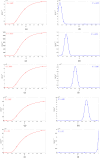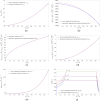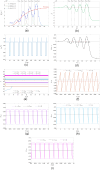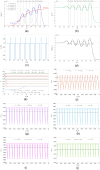An analytical approach to engineer multistability in the oscillatory response of a pulse-driven ReRAM
- PMID: 38454014
- PMCID: PMC10920777
- DOI: 10.1038/s41598-024-55255-7
An analytical approach to engineer multistability in the oscillatory response of a pulse-driven ReRAM
Erratum in
-
Author Correction: An analytical approach to engineer multistability in the oscillatory response of a pulse-driven ReRAM.Sci Rep. 2024 Sep 3;14(1):20488. doi: 10.1038/s41598-024-69891-6. Sci Rep. 2024. PMID: 39227631 Free PMC article. No abstract available.
Abstract
A nonlinear system, exhibiting a unique asymptotic behaviour, while being continuously subject to a stimulus from a certain class, is said to suffer from fading memory. This interesting phenomenon was first uncovered in a non-volatile tantalum oxide-based memristor from Hewlett Packard Labs back in 2016 out of a deep numerical investigation of a predictive mathematical description, known as the Strachan model, later corroborated by experimental validation. It was then found out that fading memory is ubiquitous in non-volatile resistance switching memories. A nonlinear system may however also exhibit a local form of fading memory, in case, under an excitation from a given family, it may approach one of a number of distinct attractors, depending upon the initial condition. A recent bifurcation study of the Strachan model revealed how, under specific train stimuli, composed of two square pulses of opposite polarity per cycle, the simplest form of local fading memory affects the transient dynamics of the aforementioned Resistive Random Access Memory cell, which, would asymptotically act as a bistable oscillator. In this manuscript we propose an analytical methodology, based on the application of analysis tools from Nonlinear System Theory to the Strachan model, to craft the properties of a generalised pulse train stimulus in such a way to induce the emergence of complex local fading memory effects in the nano-device, which would consequently display an interesting tuneable multistable oscillatory response, around desired resistance states. The last part of the manuscript discusses a case study, shedding light on a potential application of the local history erase effects, induced in the device via pulse train stimulation, for compensating the unwanted yet unavoidable drifts in its resistance state under power off conditions.
Keywords: Fading memory; Local fading memory; Multistability; Nonvolatility; ReRAM.
© 2024. The Author(s).
Conflict of interest statement
The authors declare no competing interests.
Figures
















References
-
- Ielmini, D. & Waser, R. Resistive Switching: From Fundamentals of Nanoionic Redox Processes to Memristive Device Applications 1st edn. (Wiley, 2016).
-
- Corinto, F., Forti, M. & Chua, L. Nonlinear Circuits and Systems with Memristors: Nonlinear Dynamics and Analogue Computing via the Flux-Charge Analysis Method 1st edn. (Springer, 2021).
-
- Ascoli, A., Tetzlaff, R., Chua, L., Strachan, J. & Williams, R. History erase effect in a non-volatile memristor. IEEE Trans. Circuits Syst.I(63), 389–400 (2016).10.1109/TCSI.2016.2525043 - DOI
-
- Strachan, J. et al. State dynamics and modeling of tantalum oxide memristors. IEEE Trans. Electron. Devices60, 2194–2202 (2013).10.1109/TED.2013.2264476 - DOI
-
- Ascoli, A., Tetzlaff, R., Chua, L., Strachan, J. & Williams, R. Memory loss in a tantalum oxide memristor. In Advances in Science and Technology, Proceedings of International Conference on Smart Materials, Structures and Systems (Perugia, Italy, 5–9 June 2016), vol. 99, 94–101 (Trans Tech Publications, 2017).
LinkOut - more resources
Full Text Sources

